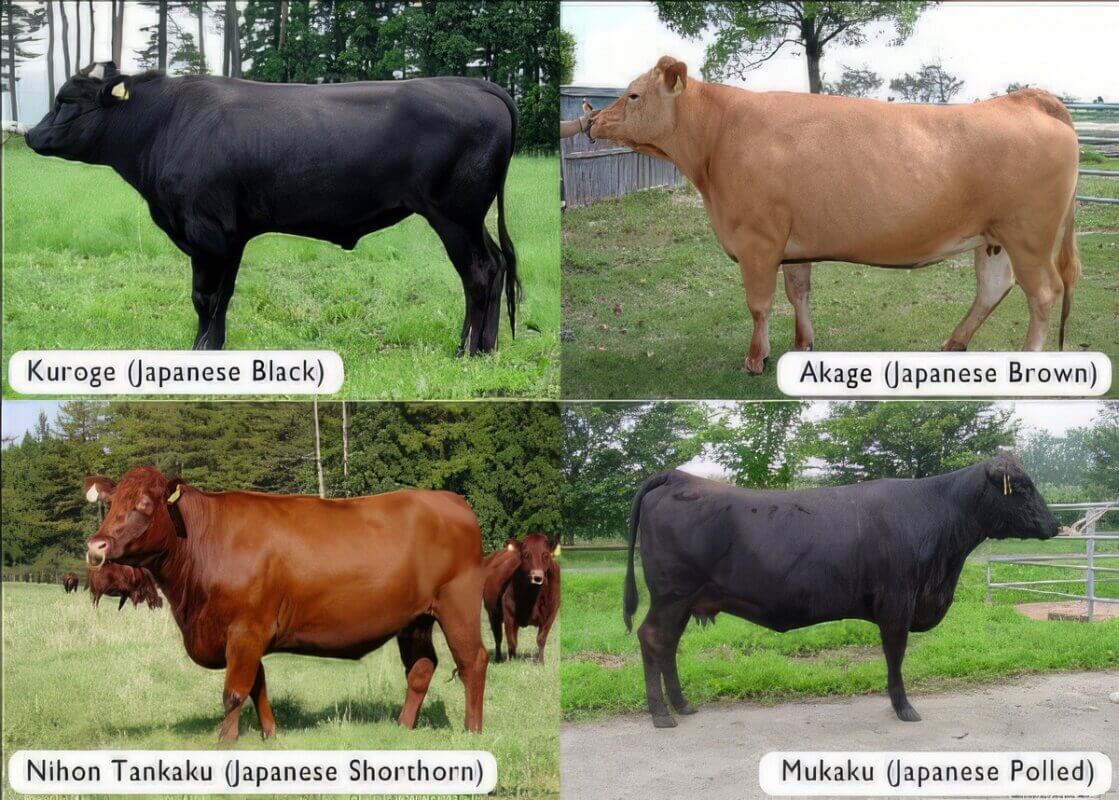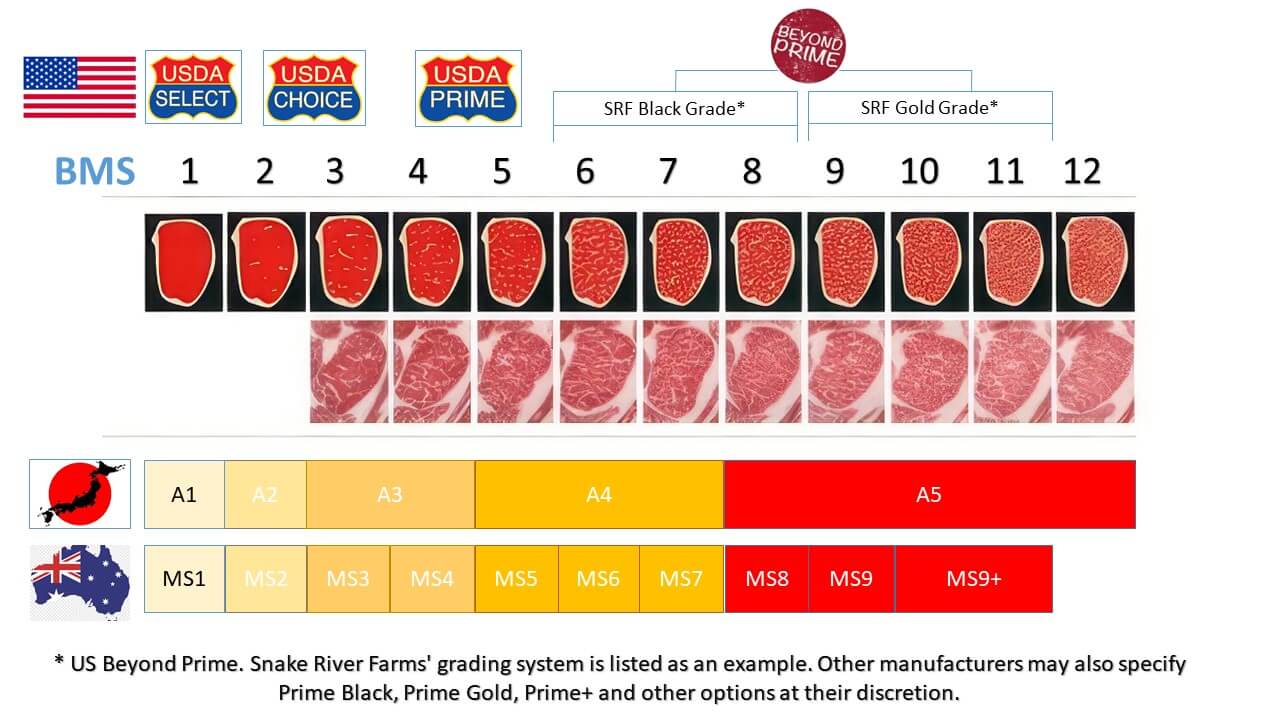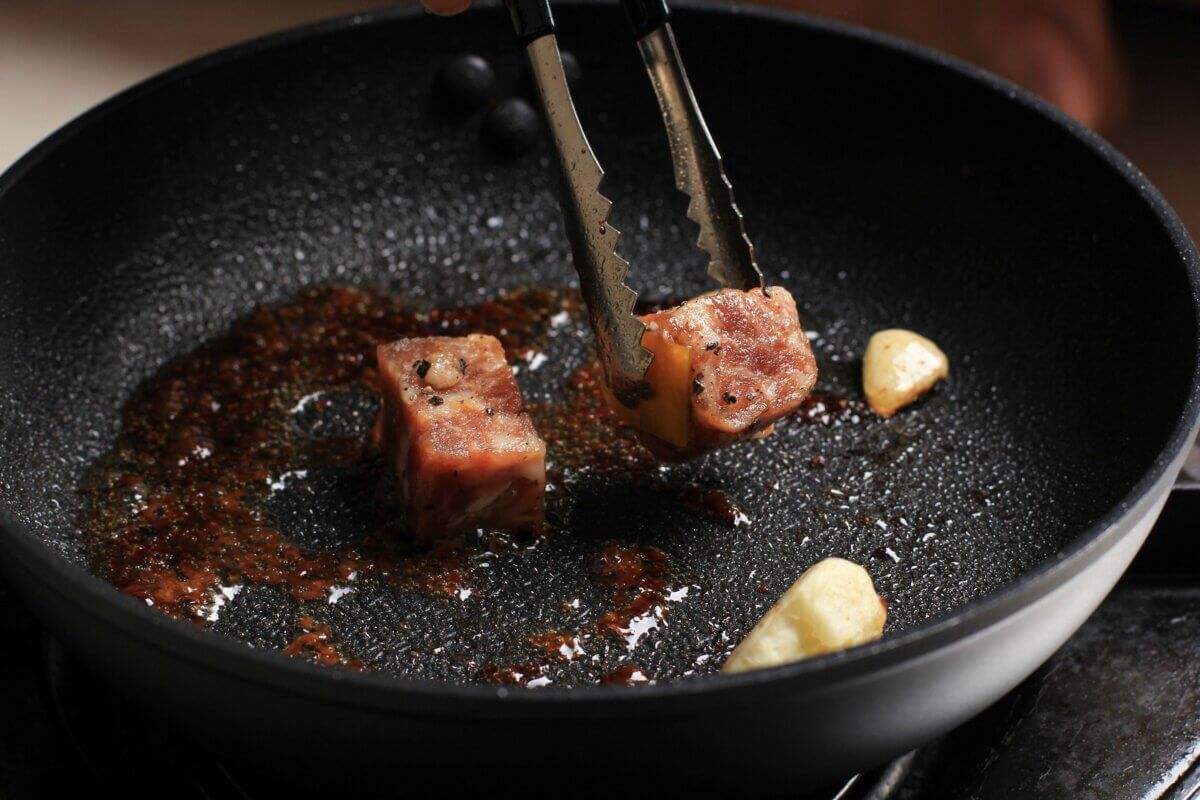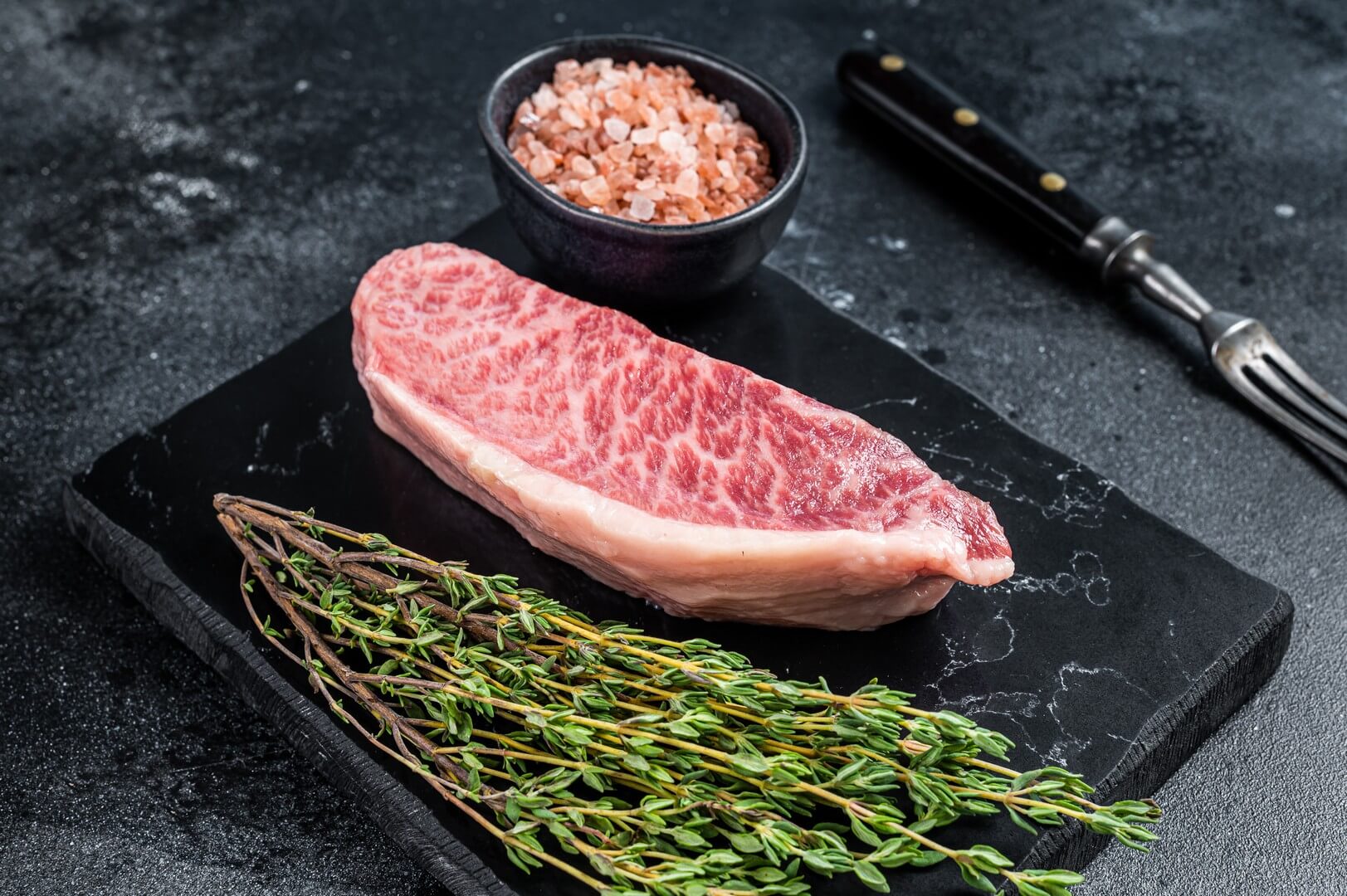This comprehensive analysis will explore the differences between Kobe and Wagyu beef, two highly-regarded beef varieties. These beef types are considered the highest quality and are sought after by gourmet restaurants worldwide.
Kobe and Wagyu beef are known for their exceptional flavor and texture due to the unique cattle-rearing techniques and particular traits associated with each type.
Definitions and Origins

Kobe Beef: Kobe is a type of Wagyu beef from the Tajima strain of Japanese Black cattle, raised in Japan’s Hyogo Prefecture according to strict traditions and regulations. The name ‘Kobe’ is protected by a geographical indication, meaning only beef meeting rigorous standards can bear the title. This high-grade beef is renowned for its flavor, tenderness, and well-marbled texture.
Wagyu Beef: ‘Wagyu’ translates to ‘Japanese cow’ and refers to four breeds of Japanese cattle: Japanese Black, Japanese Brown, Japanese Shorthorn, and Japanese Polled. Wagyu beef can come from any of these breeds. While Kobe is a type of Wagyu, not all Wagyu beef is Kobe. Wagyu is celebrated for its high degree of marbling, lending to a rich, melt-in-your-mouth quality.
The Kobe Beef

Kobe beef comes from the Tajima strain of Japanese Black cattle, traditionally raised in the Hyogo Prefecture. The cattle are presented in a stress-free environment with a diet rich in local grain fodder. This highly controlled upbringing contributes to the superior quality of Kobe beef.
The defining characteristic of Kobe beef is its extraordinary marbling—the intramuscular fat dispersed evenly throughout the meat. This marbling isn’t just for show—it contributes significantly to the beef’s flavor and texture. When cooked, the fat melts, infusing the meat with a rich, buttery, sweet, and savory flavor. This also creates a tender, melt-in-your-mouth texture that is a signature of Kobe beef.
The beef must pass a strict certification and grading process to bear the Kobe name. It must achieve a grade of 4 or 5 on the Japanese Meat Grading Association’s scale and a Beef Marbling Score (BMS) of 6-12. The cattle must also be born, raised, and slaughtered in Hyogo Prefecture and be processed in approved slaughterhouses. Only a few thousand head of cattle meet these rigorous standards yearly, making Kobe beef a rare and precious commodity.
The Wagyu Beef
When discussing Kobe vs Wagyu beef, it’s essential to understand that Wagyu is not a singular type of beef. Wagyu refers to four breeds of Japanese cattle: Japanese Black, Japanese Brown, Japanese Shorthorn, and Japanese Polled. Each breed can produce Wagyu beef, provided they’re reared in Japan and meet specific standards.
The upbringing, diet, and living conditions of Wagyu cattle significantly impact beef quality. These cattle are typically raised in a stress-free environment and fed a special grain-rich diet to encourage marbling. This diet and genetic factors create the beautiful marbling effect in Wagyu beef.
Marbling in Wagyu beef is a crucial contributor to its flavor and texture. The evenly distributed intramuscular fat melts when cooked, enriching the meat with a velvety, buttery flavor and yielding a supremely tender texture.
The certification and grading process for Wagyu beef is strict, similar to Kobe. It must achieve a Beef Marbling Score (BMS) of at least 3 and a Japanese Meat Grading Association score of 4 or 5. However, while all Kobe beef is Wagyu, not all Wagyu is Kobe.
The Comparison: Kobe vs Wagyu beef
In the Kobe vs Wagyu beef debate, several factors come into play.
Regarding taste, both Kobe and Wagyu beef are celebrated for their luxurious flavor, tenderness, and rich buttery taste. However, Kobe beef often has a more intense marbling, leading to a more pronounced melt-in-your-mouth experience.
Nutritionally, Kobe and Wagyu beef have higher fat content than other beef types, contributing to their rich flavor. They also contain enough oleic acid, a heart-healthy monounsaturated fat. However, the caloric content can be pretty high due to the marbling.
Price-wise, both Kobe and Wagyu beef are premium products, but Kobe is typically more expensive due to its stricter production requirements and relative rarity.
Comparison Table: Kobe vs Wagyu Beef
| Aspect | Kobe Beef | Wagyu Beef |
| Origin | Hyogo Prefecture, Japan | Anywhere in Japan |
| Cattle Breed | Tajima strain of Japanese Black cattle | Japanese Black, Japanese Brown, Japanese Shorthorn, Japanese Polled |
| Marbling | Exceptional marbling, BMS 6-12 | High marbling, BMS at least 3 |
| Flavor & Texture | Rich, buttery flavor, tender texture | Rich, buttery flavor, tender texture |
| Certification | Must be born, raised, and slaughtered in Hyogo Prefecture, Japan. Must achieve a grade of 4 or 5 on the JMGA scale | Must achieve a JMGA score of 4 or 5 |
| Price | Generally more expensive | Generally less expensive than Kobe but still premium priced |
Misconceptions and Confusions
In the discussion of Kobe vs Wagyu beef, several misconceptions persist.
One common misconception is that Kobe and Wagyu are the same. While all Kobe beef is Wagyu, not all Wagyu beef is Kobe. Kobe beef comes from a specific breed raised in a particular region, whereas Wagyu can be any of four breeds raised anywhere in Japan.
Another issue is the misuse of these terms in marketing. Some sellers may label their beef as ‘Kobe-style’ or ‘Wagyu-style,’ which can be misleading. Authentic Kobe and Wagyu beef are only from Japan, meeting strict grading and certification processes.
Lastly, the belief that more marbling always means better beef is not necessarily accurate. While marbling contributes to flavor and tenderness, personal preference for leaner or fattier meat varies.
How to Choose and Cook

Knowing how to choose and cook these meats can make a difference in your culinary experience in the realm of Kobe vs Wagyu beef.
When choosing Kobe or Wagyu beef, always look for a reliable and certified seller. For Kobe, ensure the meat has the official Kobe Beef logo and chrysanthemum to guarantee authenticity. For Wagyu, look for the grading on the beef to ascertain its quality.
Cooking Kobe and Wagyu beef is a delicate process. The aim is to melt the fat evenly, allowing it to infuse the meat. Steaks are best cooked to medium-rare to retain the marbling’s richness. Searing on high heat for a short time is popular, while others prefer slow roasting. Simplicity is key—these meats’ natural flavors should shine.
In the comparison of Kobe vs Wagyu beef, it’s evident that both these beef types hold their unique allure. Both are celebrated for their exceptional marbling, rich flavor, and tender texture. However, key differences lie in their origins, certification processes, and cattle breeds.
Whether you lean towards Kobe or Wagyu in the Kobe vs Wagyu beef debate, it’s undeniable.
A very good video on the flavors of Kobe beef by Mark Wiens:
FAQ
References
- Japanese Meat Grading Association (JMGA). The Japanese Beef Marbling Score. Japan. http://www.jmi.or.jp/en/info/index2.html
- Kobe Beef Marketing & Distribution Promotion Association. What is Kobe Beef? Kobe, Japan. https://www.kobe-niku.jp/en/top.html
- Wagyu International. Japanese Wagyu. Japan. https://www.wagyuinternational.com
- Sasaki, K., Motoyama, M., Narita, T., Hagi, T., Ojima, K., Oe, M., … & Mannen, H. (2018). Genetic factors responsible for longissimus muscle thickness and subcutaneous fat thickness in a Duroc purebred population. Animal Science Journal, 89(3), 477-484.
- Obuz, E., Dikeman, M. E., Grobbel, J. P., Stephens, J. W., & Loughin, T. M. (2004). Beef longissimus lumborum, biceps femoris, and deep pectoralis Warner-Bratzler shear force is affected differently by endpoint temperature, cooking method, and USDA quality grade. Meat Science, 68(3), 243-248.
